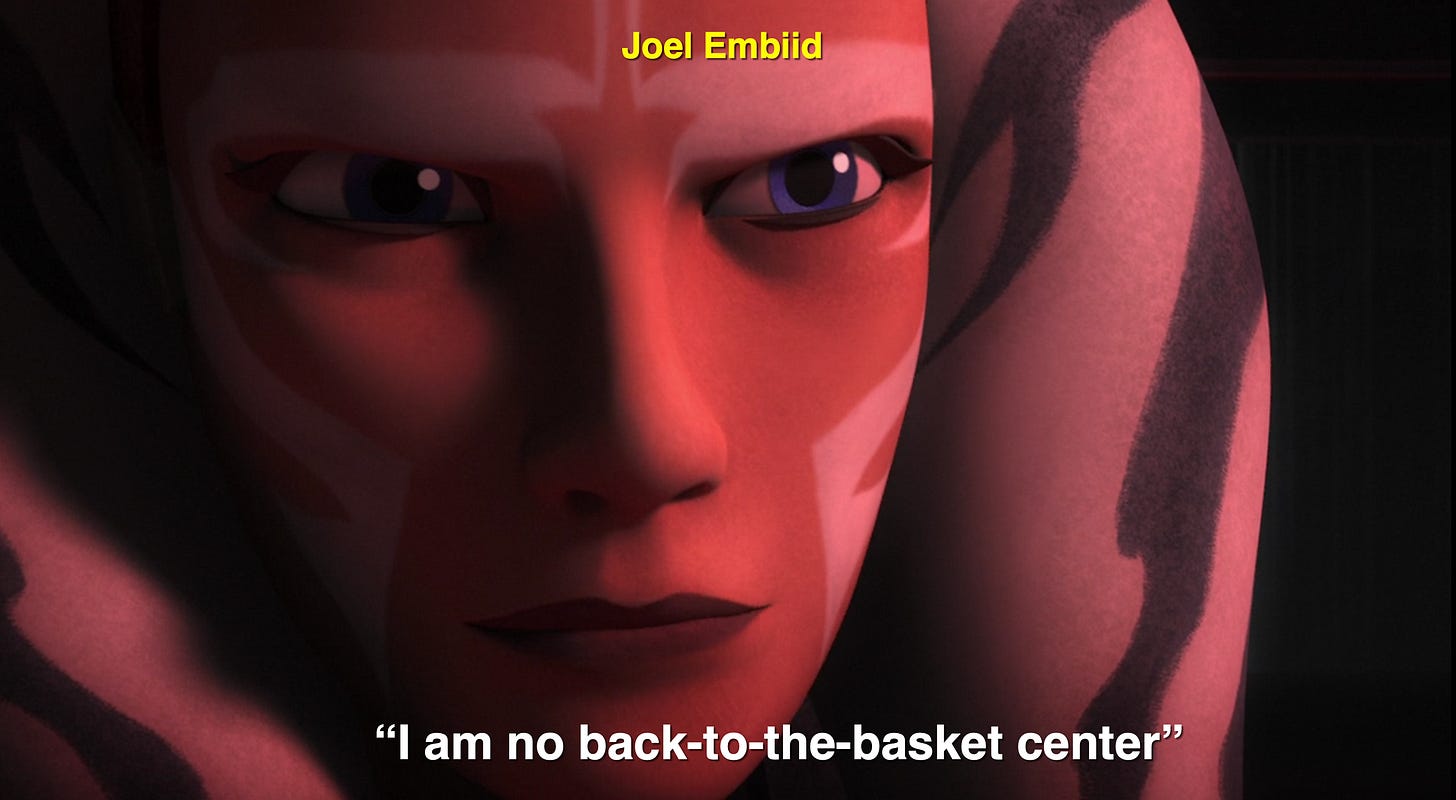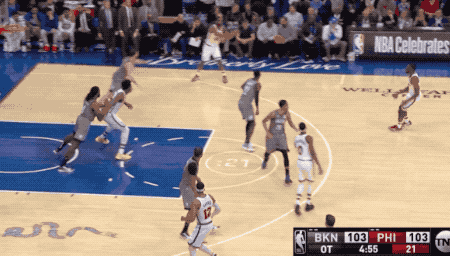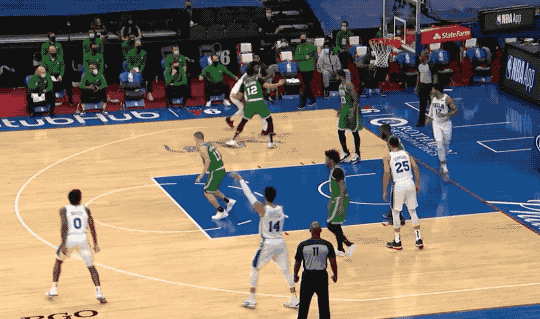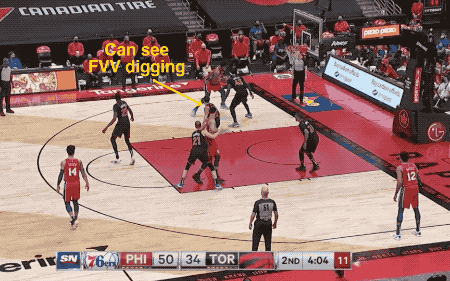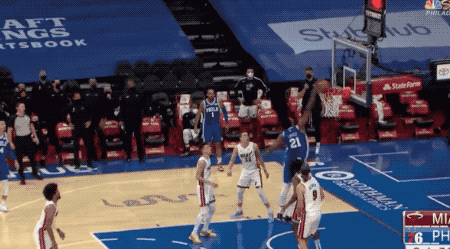The face-up low-post monster
Joel Embiid is dominating the way the NBA's past great centers once did ... except for one key difference.
What position does Joel Embiid play?
This sounds like a strange question, and it kind of is. Obviously Joel Embiid is a center, and a throwback one at that. He obviously has guard skills — he’d be pretty damn ordinary if he didn’t. But if you had to pick one player who most resembles the classic, dominant, back-to-the-basket, low-post centers of years and eras past, you’d say Joel Embiid.
And you’d would be right, for the most part. Though Embiid can shoot threes, he’s shooting less of them this season and *Shaq voice* dominating like never before. He’s doing more of his work below the free-throw line when he previously spent too much time away from the basket. He’s in shape, motivated by some combination of playoff failure, a new coach, fatherhood, and some intangible fire within that he’s now channeling properly. He’s narrowed his skill set after years of trying to expand it to give Ben Simmons room and/or mask the 76ers’ perimeter shortcomings. All this suggests that he’s playing more like what we commonly call a “center,” with his production and Philly’s record speaking for themselves.
So why ask such a silly question? Isn’t Embiid’s position obvious? Why bother with an epistemological question when the answer is clearly “throwback low-post, back-to-the-basket center?”
Because while your initial answer was mostly right, it’s also wrong about one small thing — or at least more wrong about it than in past years. Every part of “throwback low-post, back-to-the-basket center” is correct.
Every part except “back-to-the-basket.”
Take a look at these two breathtaking moves. One is against a like(ish)-sized player in Anthony Davis. The other is against Jeff Green, a smaller guy who you’d think would be powerless against a giant backing their ass into him.
Tell me: what is Joel Embiid doing in both situations?
The answer is that he’s turning to face them instead of backing them down. He’s in post(ish) position, but he’s not posting them up.
Instead, he’s holding the ball with a live dribble in a classic triple-threat position, the same way a wing player would when going one-on-one.
Then, he’s beating them to the spot with a quick step, driving his shoulders past theirs, and finishing the play with two hard steps forward or a counter move back the other way. These are moves a smaller, quicker player uses to get by bigger, slower players … except Embiid’s using them on smaller players, too. He’s beating players with speed while also happening to be much bigger than them.
This may seem like an odd use of Embiid’s skill set. Why have your dominant low-post scorer turn and face his defenders like a guard? Why not just back them into the rim like the game’s previous great centers did? Why risk your biggest guy dribbling into the path of a smaller defenders?
It’s worth noting that Embiid hasn’t tossed out backdowns entirely. Even if turning and facing has become his his bread and butter, it’s nice to have plays like this in his back pocket.
But turning and facing rather than backing down a defender in the post has plenty of hidden advantages, even for someone as big as Embiid. For one, it reduces the need to dribble at all. It’s easy for Embiid to just jab and shoot over the top of his smaller defender when he is already looking at the basket instead of needing to twirl his body to face it.
Embiid’s mid-range shooting percentages are outrageous this season. As of Feb. 25, he’s hitting 49 percent of his shots from 10-16 feet and a sizzling 61 percent from 16 feet to the three-point line. Both are well above his career norms, and the second number is well above anyone’s career norms. If you glance only at those numbers without seeing how Embiid gets those shots, you could argue he’s due for a major shooting regression.
But I doubt that’ll happen, at least not in a significant enough way to blunt the effectiveness of Embiid’s strategic (turn-and-)about face. Last season, less than 23 percent of Embiid’s shots and just 20 percent of his two-pointers were classified as pull-up jumpers. This year, those numbers have jumped to 32.3 percent and 28.6 percent, respectively. He took only 3.2 pull-up two-pointers per game last season, but is up to more than five per game this year.
That’s not an ideal distribution for a normal player, but Joel Embiid is not normal. In his case, that means many more mid-range shots like this.
And fewer like this.
Which one do you think is easier for a guy with such a soft shooting touch? If turning and facing the basket means more of the former and less of the latter, it’s well worth the risk that Embiid may need to dribble more as a counter move and thus bring the ball down to smaller defenders’ levels.
Not that it’s a problem when he does. Embiid’s handle has become so tight that he can wedge through smaller defenders as easily as lanky wing scorers do. Good luck trying to beat him to the spot.
Even if you do, you won’t have the core strength to square him up with your chest and angle him off his driving path. Embiid’s always been a foul magnet, but exchanging more low-post back-ins with face-up drives has turned him into a foul gravity well. He’s attempting nearly 12 free throws a game this year, most in the league by a mile, and he’s making 86 percent of them. That’s more that 10 points per game from the line, a massive number when considering only one other player in the entire league (Trae Young) makes more than 7.1 free throws per contest.
Embiid, Rivers, and the 76ers have internalized one essential truth of the modern game: smaller defenders can more easily maintain a lower center of gravity if the offensive player backs them down than if they face them up. That’s one reason, among many, that the post-up has become less fashionable in the last 20 years.
But none of that applies if the guy operating in the low post faces up his defender up as if he was on the perimeter. Do that, and defenders big and small(er) are unable to maintain enough core strength to stand their ground and keep their arms to their sides.
But there’s an even more elementary reason for Embiid to turn and face his defender rather than backing them down. Put simply: it’s a lot easier to handle double teams when you can actually see them.
Reading double-team coverages has always been Embiid’s Achilles heel. Smart teams (sup, Celtics) fronted him to make low-post catches difficult, then dug down off their men to flood his senses. They made it hard for the 76ers to get Embiid the ball in his preferred locations, then baited him into indecision, ineffective passes, or forced shots against multiple defenders. This was a constant source of frustration for 76ers fans and only further proved the theory that classic low-post play is impossible in today’s NBA.
That theory is still mostly right. Embiid will never play with the open space Hakeem Olajuwon enjoyed in his two title-winning seasons, when illegal defense rules made double-team coverages less sophisticated. But rather than throw up their hands at the predicament, the new 76ers braintrust made it a priority to give Embiid as many tools as possible to improve his biggest flaw.
Changing the personnel around Embiid has certainly helped. New general manager Daryl Morey was shrewd to acquire Seth Curry and Danny Green, two elite three-point shooters who are also savvy cutters, entry passers, and floor spacers even when they aren’t receiving kickout passes. The 76ers’ playing rotation, once devoid of spot-up shooting, now includes just two non-shooting non-centers in Ben Simmons and Matisse Thybulle. That’s certainly given Embiid a lot more room to make opponent pay for double-teaming him.
But Rivers’ deployment of Embiid as more of a face-up low-post player instead of a back-to-the-basket one has done even more to turn his biggest weakness into a relative strength. It’s allowed Embiid to pause before dribbling, scan the floor, and then react accordingly. He sees where his teammates are standing and can more easily plot out where they might cut as he attacks. These are way easier passes to make when he can actually see them instead of having to feel them while backing down.
Rivers has also deployed Embiid more in the middle of the floor to further simplify his shoot-drive-or-pass decisions. You’ll often see Embiid run what seems like a pick and roll, but is actually just a pretense for him to carve out position at the free-throw line extended. All of the same advantages of facing up on the block still apply. The jab-jab-shoot move is still money in the bank.
One dribble, and he can be at the rim.
Or far enough from it to make a second move.
And there’s plenty of space for Embiid to reverse pivot and shoot a fadeaway.
But giving Embiid the ball in the middle of the floor has another advantage: it’s almost impossible to double-team him effectively. Not only can he see exactly where to pass if a second defender comes all the way to him, but the penalty of a dig (or not digging) off one of the other four players is much deadlier when the floor is that open.
Combine these tactical adjustments with Embiid’s improved conditioning and sense of purpose, and you get what we’re seeing this year. Maybe, just maybe, you’ll also get the game’s most prestigious individual regular-season honor going to a throwback low-post, back-to-the-basket center for the first time in two decades.
Just don’t forget to omit one of those adjectives when describing Embiid’s game.





